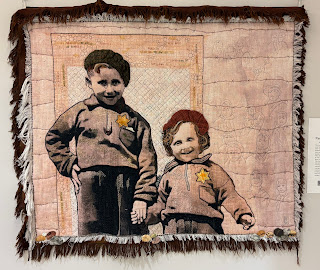Studio Art Quilt Associates Regional NC/VA group is concluding an exhibit at the Petersburg Area Art League, Petersburg, VA. The theme was "Facade", which could be interpreted in multiple ways from architectural fronts, to the portrayal of emotions, or the masks we wear. The quilts in this exhibit covered the gamut. Sue's submission to this juried exhibit is "Beyond the Door", a realistic portrayal of Midhope Castle in West Lothian, Scotland.
This piece was painted on a midweight canvas fabric using a variety of textile paints, walnut ink, and Inktense paint sticks. The grasses and ferns around the steps and door are Thermofax screen prints. This was a unique project for Sue in that it was all done with paints rather than pieced fabrics.
Here are some other outstanding quilts in this exhibit.





































